I love my kitchen but it’s not large so it gets messy fast – add two growing young daughters, a husband and a cat – you have to stay organized....
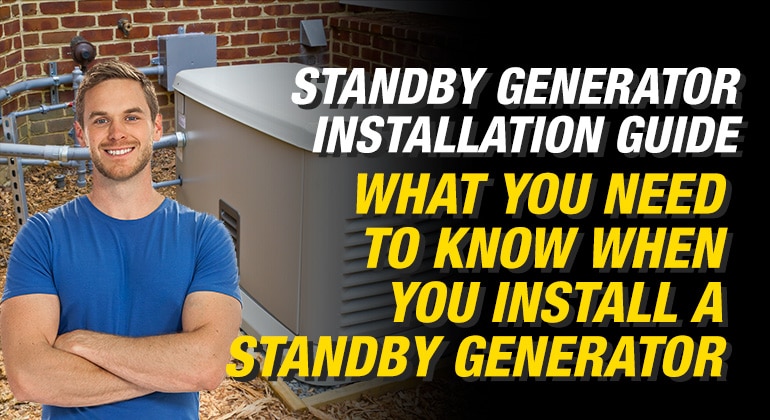
Your Complete Guide On Standby Generator Installation
By Mike Holmes Jr
Mike’s Advice / Home Safety & Maintenance
Tuesday, September 27th, 2022 @ 10:40am
What You Need to Know When You Install a Standby Generator
I recently had a conversation with colleagues of mine from ESA (Electrical Safety Authority), and they mentioned that they’ve seen an increase in the number of standby generator purchases. Many homeowners are investing in standby or whole-home generators to protect their homes from power outages, especially with the increase in the number of storms we’ve seen recently.
Storms with heavy rain, lightning, and high winds can typically cause power outages as well as damaged roofs, siding, downed trees, and downed electrical power lines, to name a few. Before making a purchase, you must first determine whether a backup generator is worthwhile for your situation.

Before making a purchase, you must first determine whether a backup generator is worthwhile for your situation.
Here’s a guide on what you need to know before purchasing and installing a standby generator in your home.
Do You Need A Generator?
A backup generator may be worth the money if you live in an area where severe storms, flooding, or extended power outages are frequent, offering you peace of mind and potentially saving you thousands of dollars in possible damage.
There are two main kinds of generators, portable and standby. Portable generators are limited to 12 kilowatts and if you have 240 volts, they need to be grounded to the frame.
Standby generators support a much greater power draw and can be connected to your home’s main panel. They are powered by diesel, propane or natural gas.
What is A Generator?
Let’s take a step back and first talk about what is a generator. A generator transforms mechanical energy into electrical energy. When the power into the electrical grid is down, it powers your electronics and appliances. When there is a power outage or a natural disaster, such as a hurricane, heavy ice, or snowfall, generators are a piece of essential safety equipment to have in your home.
You can continue to use your home’s heat, lights, necessary appliances, and medical machines if you have a generator. A generator can lessen the inconvenience and guarantee that an unexpected blackout won’t disrupt your day if you live in an area that experiences regular but brief outages.
How Does A Standby Generator Work
Power Outage
The generator is connected to the building’s electrical system via an automatic transfer switch (ATS), which automatically switches between utility power during normal operation and generator power during a power loss. The engine starts automatically with the help of an alternator when the generator detects a power outage.
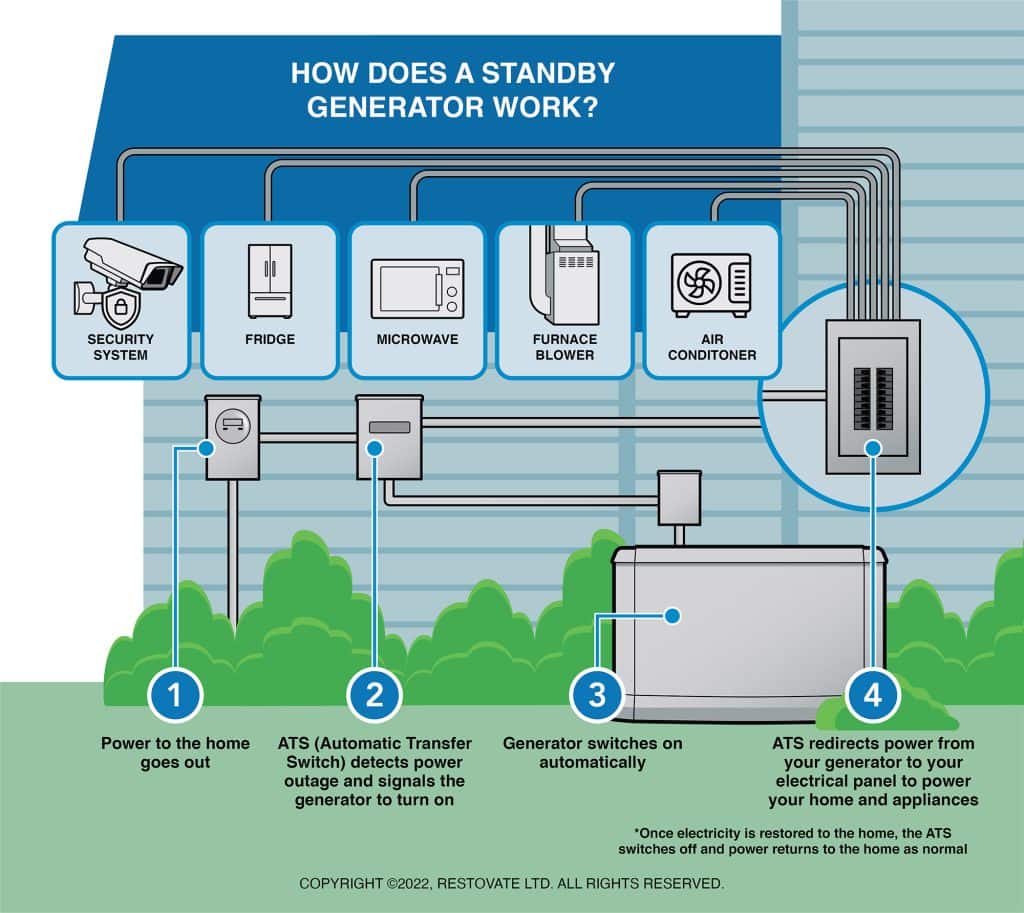
Illustration showing how a standby generator works with the help of an automatic transfer switch.
When the Power Comes Back on
When the power is restored, the automatic transfer switch cuts the power to the generator and returns it to the grid automatically.

How Power is restored. Illustration from Electrical Safety Authority (ESA).
Portable Generator vs. Standby Generator
There are three main kinds of generators, inverter, portable, and standby.
Inverter Generators
Inverter generators are similar to portable generators and ideal for camping, boating, and other recreational activities as they can store DC power. In addition to powering lights, heaters, fans, radios, smartphones, and other devices.
They are also typically quieter, lightweight, and easy to transport than other generators. They generate AC electricity and convert it to DC power, and back again to AC to create a cleaner wave of electricity, using an engine and an alternator. Ideal for lights, fans, etc.
Tip: You can usually connect two inverter generators together for twice the power.
However, the most common generator types are portable and standby generators.
Portable Generator
Portable generators are affordable and capable of powering your home’s essential appliances. Regular portable generators run on gasoline and go through 12 to 20 gallons (45 to 75 liters) per day, depending on the generator and the load it’s powering. So, having extra gasoline around needs to be considered.

Portable models are often used on job sites to power air compressors, nail guns, saws, hammer drills, and other equipment.
The other thing to consider is that you must be at home to connect to the power. This doesn’t happen automatically as it would with a standby generator. Therefore, if you go for a trip the day before a power outage, you run the risk of returning home to a host of problems, from a flooded basement (caused by a broken sump pump) to a refrigerator or freezer stocked with perishables that have gone bad.
Portable generators are generally loud. There is also the risk of carbon monoxide poisoning from the engine exhaust. For this reason, the portable generator must be at least ten feet away from the house or an enclosed space, like a garage, for example. The generator still requires some protection from the elements while also providing proper air circulation and movement. Make sure you factor into your generator budget the cost of a store-bought or DIY enclosure.
TIP: The best portable generators for residential use will have a 12-volt plug – ideal for charging smartphones and gadgets.
Standby Generator
A standby generator is placed in the majority of the projects on which I work. Me, I want to be entirely protected in the case of a significant power outage, so we opted to install a home backup generator.

We install standby generators on a lot of our projects to give homeowners peace of mind knowing their home is protected in case of a power outage.
Because it monitors your home’s electrical supply, a standby generator gives the finest coverage. When there is a power outage, it instantly kicks in and begins supplying power straight to your home’s electrical system through a transfer switch. Isn’t that convenient for when you’re gone from home for an extended amount of time?
Reasons to Install a Standby Generator for Storm Season
Every homeowner should think about getting a standby generator to protect their house and their loved ones. Because a standby generator will keep your vital mechanics powered during an outage, it can help you avoid things like rotting food and malfunctioning appliances, which can lead to expensive repairs.
Having a generator on standby can provide peace of mind during a power loss due to changing weather and unanticipated scenarios.
RELATED
Advantages of Having a Whole-House Standby Generator
- Dependable: Get automatic emergency backup power moments after a power outage (practically seamless)
- Convenient: Whole-house generators offer blackout protection twenty-four hours a day, seven days a week.
- Long-lasting: They are permanently installed and typically last 10 – 15 years or more
- Easy Upkeep: Liquid propane or natural gas, can be used to power the machine
- Versatile: Are adaptable and can power all the circuits in your house or just a few
- Quieter: Consider models with unique features that run the unit more quietly or carry out weekly self-diagnostic tests when selecting the finest generator for home backup.
RELATED
Noise, Noise, Noise
The downside to most generators is that they can be noisy. So, it’s important to find this out before installing your unit and ensure that it is located in an area that can protect you, your neighbours, and wildlife from the noise.
With portable models, the inverters tend to be quieter, but they are also typically less powerful. When it comes to standby generators, they can also be noisy but there are a few things you can do to minimize the noise.
Install The Generator A Little Further From Your Home
You can position your generator further away from your home, windows and doors. With standby generators make sure the exhausts are positioned away from your home. Some generators have their pipes facing upwards which can also lessen the noise.
Vibration Absorbing Pad To Reduce The Generator Noise
You can also place your generator on a vibration-absorbing pad. These are specially designed to lessen the noise. Another option is to purchase a noise reduction cage or box as that can significantly reduce the noise without inhibiting airflow or cooling requirements. Some people also opt to build their own, but that can void the certification warranty if not done correctly.
How is a Standby Generator Connected to Your Home?
When installing an ATS, the outdoor-rated enclosed box will be mounted on the exterior of your house next to the meter. This is the more popular option. However, it can also be installed in the house provided it follows the service box requirements. The main utility power then needs to be turned off before you go any further —and make sure your generator is in the off position.
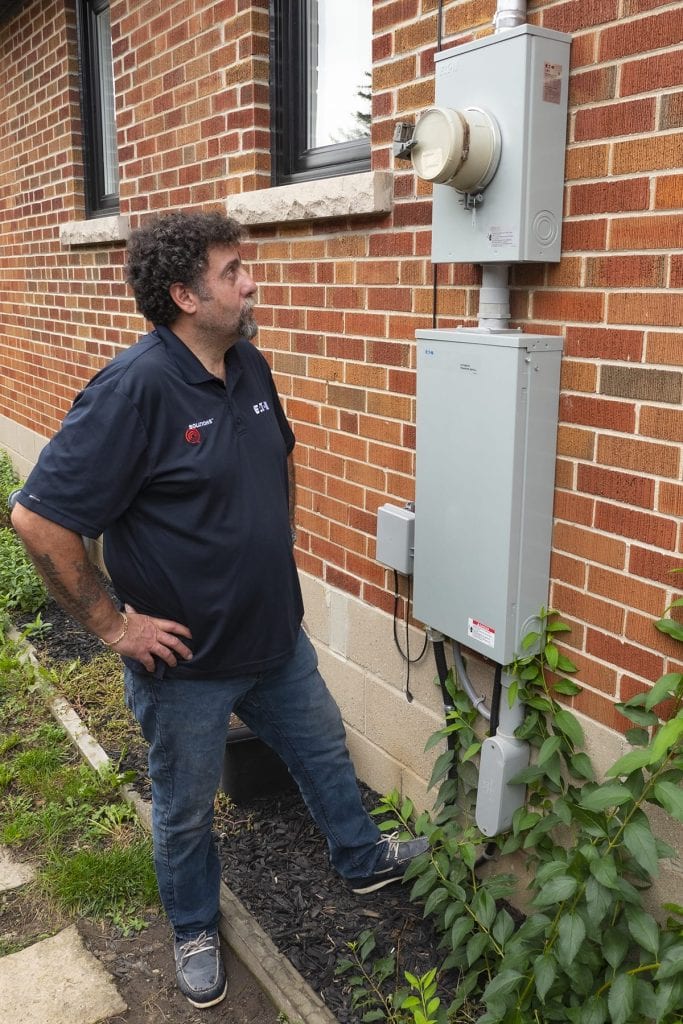
Frank Cozzolino, Licensed Electrical Contractor installing an Eaton Automatic Transfer Switch on site before the standby generator is installed.
Once that’s done, connect the power cables from your home to the unit with the mounted ATS box in place. The utility power source cable, the service disconnect-circuit breaker, and customer load leads are then all connected to the transfer switch. Finally, the generator power source cables are connected.
Next, the standby generator needs the battery and fuses to be installed and connected within the generator. Before starting the generator up for the first time, check the oil (like a car) to ensure it’s at the correct level. You should also check the fuel supply and provide that the fuel line has been purged and tested.
The final step includes testing and verifying the generator using the manual power option. Once completed, add the fuses to the ATS switch. The generator can also be activated online using an app.
After a series of tests, the generator is ready to turn on automatically after a power outage. The turnaround time is approximately 7 to 10 seconds.

Installing an automatic transfer switch for a standby generator with Frank on site.
What Is A Transfer Switch
When installing a standby generator, I recommend installing a transfer switch to operate it.
If you’re in the US, your licensed electrical contractor may suggest an interlock kit instead. However, in Canada these are not permitted as once the plate is unscrewed, or becomes loose, it could cause a safety issue or it could just fall off over time, so I wouldn’t recommend it.
Protect yourself and your family and install a certified automatic or manual transfer switch with a licensed electrical contractor!
Transfer Switch Installation
A transfer switch isolates the circuits in the house that you want to power. All other circuits are left without power to prevent overloading. The transfer switch also electrically isolates the generator and the house from the grid.
This stops electrically generated power from back feeding onto the grid. This is very important as it can help prevent fires, or utility workers from getting hurt if they are trying to fix things and bring the power back on. The switch also stops the house from being powered by utility power while the generator is running, which if it happens can cause an electrical fire or the generator to catch on fire.
Site Survey Before Installing a Standby Generator
Every homeowner’s needs will be different, that’s why having a site survey is so important. It also needs to be done by a licensed electrical contracting business or by a professional generator dealer.
Things like property measurements in relation to the home, electrical needs, electrical panel inspection, meter location (needs clear access, without shrubs), location of your main service utility line, and gas lines. The further you go from the meter, the more it’s going to cost.
Tip: There’s no way a contractor can give you a realistic price on a standby generator installation without doing a site survey. Yes, they can give you a range, but without actually seeing where the generator will go and what shape the homeowner’s electrical is in – the range won’t be correct!
Can I Install a Standby Generator Myself?
No, installing a standby generator is never a DIY job! It is extremely risky, and you don’t want to put your life or that of your family at risk.
Always consult with a licensed electrical contracting business. They are trained and have passed the exams by the manufacturer with respect to their products.
In Ontario, use the contractor lookup tool on the ESA’s website, www.esasafe.com, where you can locate an LEC close to you.
It’s important to consult with a licensed gas fitter as well as your standby generator needs to be tied into a gas/propane supply. This is another reason why this is 100%, not a DIY job.
RELATED
How Do You Hook Up A Generator To A House Without A Transfer Switch
There are 4 ways you can connect the generator to the house without a transfer switch.
- Using a Breaker Box: You can connect the generator to the breaker box, using a breaker. When needed the main breaker will cut off the power supply to the generator.
- Using the Main Electrical Panel: You can also wire the generator to the main electric panel.
- Using a Through Relay: A relay can interrupt the power supply from any appliance in the house when there is a power surge or electrical issue. You can connect the generator using a relay which will allow the device switch to turn on and off automatically.
- Using Through a Power Inverter: the easiest way to connect is through a power inverter, which is a device that turns the generator’s DC power into AC power. Your home appliances can then utilize this power.
What Is The Best Place To Install a Standby Generator
You need to discuss several factors with your licensed electrician when you are preparing to install a standby generator on your property.
It’s best to place your standby generator where the prevailing winds will blow the exhaust away from your home. In addition, keep the generator away from living spaces, bedrooms, and neighbours.
Never place the generator inside a building, in a breezeway, under an overhang, or in a space blocked by trees, bushes, or other vegetation. Avoid snowdrift-prone places, and keep dogs, animals, people, and traffic away from the generator.
To keep you and your family safe, consulting with a licensed electrical contractor, your local utilities, and your local building authority is essential before you install a standby generator.
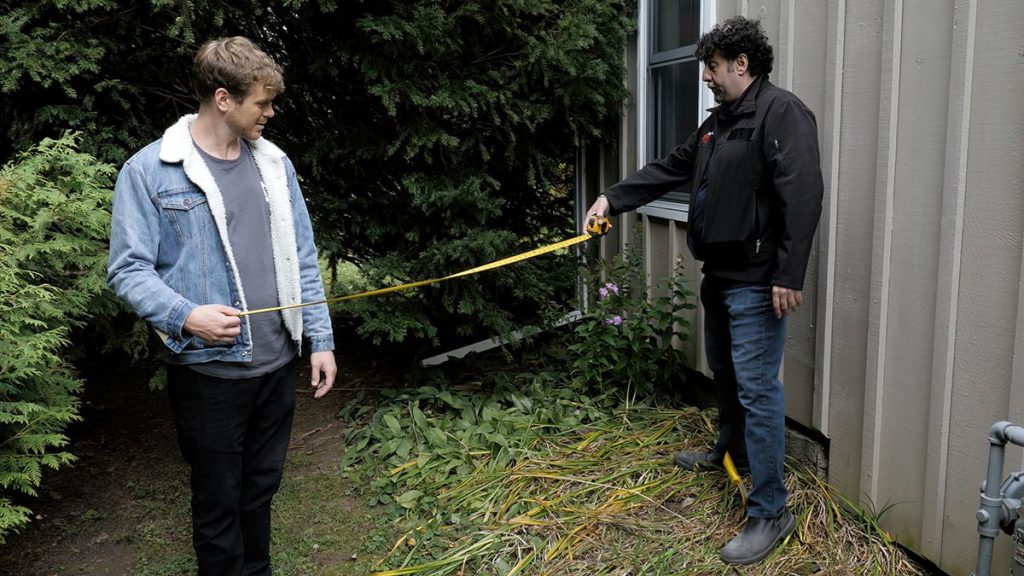
Conducting a site survey with Frank before we install our generator.
How Far Should A Standby Generator Be Placed Away From The House, Windows, and Doors
Local codes suggest at least 18 inches away from anything flammable, and 5 feet away from windows and doors. Always follow your local municipal building codes.
The NFPA (National Fire Prevention Association) code, and local city bylaws, will dictate the minimal distance between the home and the generator, the type of house siding used, and manufacturer certifications.
Standard clearances include three feet away from flammable goods and five feet from any house opening.
Can I Install the Generator Indoor
No! Never operate a generator indoors or in a garage to avoid carbon monoxide emissions. Even using fans or open windows and doors will not protect you. All generators require proper airflow and ventilation.
Which Size Of A Generator Do You Need For Your Home
The size of the generator depends on how much electricity you need and what is considered essential when you lose power. Basically, the more electricity you need, the bigger your generator will have to be.
The typical house will need about 15 to 30 kilowatts for everyday use. An average North American home needs around 8 to16 kilowatts of power for its BASIC electrical needs (a few receptacles, a few lights, a fridge, a freezer, and heat depending on where you live). In order to ensure that your home has enough electricity when the grid goes down, you’ll want at least a 14kW (20kW) generator.
Most homeowners will go to a 22kW, yet a bigger motor will not work as hard if your dependence is high. Also, motors that don’t work as hard theoretically will last longer.
Precast Concrete Pad for The Generator
A generator needs to be on level ground, which can be achieved by using a pre-cast Generator Pad (typically 3 or 4” deep). You can also create a pad made from concrete, interlock stone, flagstone, etc.
If digging is required it will have to be tamped to ensure the ground is solid and level as this will prevent sinking. Installation is made easier as gravel beds are eliminated with a concrete pad for the generator.

A generator needs to be on level ground, which can be achieved by using a pre-cast Generator Pad (typically 3 or 4” deep).
Stainless Steel Bolts to Secure the Generator and the Concrete Pad
After the generator is placed into position on the pre-cast concrete pad, remove the stainless-steel bolts from the bottom of the generator. Next, add threaded inserts into the holes and secure the generator to the concrete pad with stainless steel bolts.
No matter what type of base you use, ensure that your generator is properly fastened to the base. Make sure to use the correct stainless steel bolts.
Generator Connection – Gas Line and Line – Voltage Cable
Remember standby generators will require a gas and hydro line. By contacting a licensed gas technician, you will be able to get the proper installation done. A trench will have to be dug that can accommodate both the utility and the gas line, so keep that in mind when budgeting for installation.
Your gas technician should work with your electrician, to ensure that the gas and electrical lines are in the same trench but not installed in the same vertical plane. There should be a horizontal separation of 300mm within the trench.
Who Should You Hire To Install Your Standby Generator?
Hiring a Licensed Electrical Contractor (LEC) to Install the Transfer Switch
A Licensed Electrical Contractor will be able to look at your panel and see where the ATS (Automatic Transfer Switch) can be mounted and confirm the amount of wire that will be required for the installation. They will also help you determine the correct size of the generator and confirm everything is done according to the code and the local electrical authority.
Using the contractor lookup tool on the ESA’s website, www.esasafe.com, you can locate an LEC close to you.
RELATED
Avoid Unlicensed Electrical Contractors
Why You Should Hire A Licensed Electrical Contractor
File a Notification with ESA
In Ontario, an electrician will have to file a Notification of work with the Electrical Safety Authority (ESA), depending on the type of generator or transfer switch. In most cases, the National Code will state a permit is required as well.
Hire A Licensed Gas Fitter For Your Gas/Propane Supply
As I mentioned earlier, your standby generator will need to be hooked up to a gas/propane supply to power it. Hire a licensed gas fitter to connect your gas supply to the standby generator and ensure it’s done correctly and safely.
How Long Does it Take to Install a Standby Generator?
Total time needed to install a standby generator? Realistically 1 to 2 days. However, it can be completed in 1 day if you are organized and everyone is on the same page. Just remember you must coordinate your electrician, the disconnection of the utilities (electrical and gas), and the reconnection to electrical and gas all on the same day! That’s a lot of coordinating, that’s why we usually say it will take 2 days.
How Much Does It Cost to Install a Standby Generator
Standby generator units can range around $2,000.00 and go up depending on your needs and power (wattage). Installation costs vary based on existing gas and electrical lines. It will also depend on the automatic transfer switch. However, the average should range between $3,000.00 to $5,000.00.
Do You Need a Permit to Install a Standby Generator
Installing a standby generator is not a DIY job as installation includes electrical wiring, plumbing, and natural gas components.
To permanently connect a generator to your home’s electrical system, you must obtain an electrical permit. A Licensed Electrical Contractor (LEC) guarantees your generator is installed properly. ESA strongly advises doing so.
As for gas lines, although it is legal for property owners to build, move, repair, and maintain gas lines themselves in Ontario, doing so is extremely dangerous due to the enormous risks at stake.
Remember, you must notify your local utility board to get both electricity and gas shut off to complete the proper installation.
What To Look for When Buying A Generator
A certified certification or assessment organization must approve an electrical product or piece of electrical equipment before it can be used, sold, displayed, or marketed for sale in Ontario. Similar laws apply to other provinces and territories in Canada. The product needs to have the organization’s official label or mark to show that its safety has been independently verified.
When implemented, these regulations set the requirements for safe electrical components and installations in Ontario. Most jurisdictions follow the country’s National Electrical Standards. This is key to safeguarding customers, employees, contractors, and business owners.
Hiring a licensed electrical contractor is important to help you determine your electric power needs.
I’ve also heard about people buying second-hand generators online, due to the market shortages. However, it’s important to always check the certification mark and make sure it’s approved for use in Canada.
What Certification Marks Should the Generator Have
Look for an approved certification mark for use in Canada BEFORE you buy.
All electrical products sold in Canada must have a certification mark. Some of the most common marks include ETL, cULus, or CSA safety certification. However, you can find the full list on esasafe.com/approvalmarks.

Common certification marks in Canada to look out for when buying a generator.
How Many Wattages Do I Need?
So, how much wattage do I need in an emergency? Your best bet is to consult with a licensed electrical contractor. They will give you precise advice, especially when it comes to wattage requirements for hard-wired versus plug-in items. They can also confirm your wattage requirements by helping you pinpoint which generator is best for your situation.
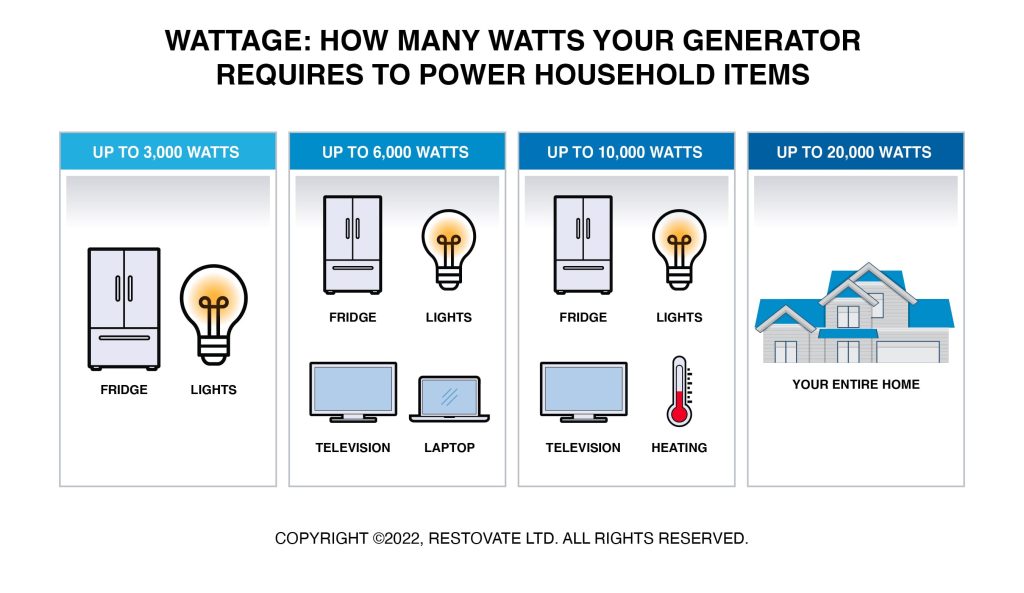
How many watts does your generator require to power household appliances?
Wattage Estimates When Buying A Generator
3,000 Watts and below: (basic inverter generator), This kind of power is adequate for running a refrigerator and a few lights.
6,000 Watts and below: (mid-size inverter generator), This kind of power is adequate for running a few items simultaneously, like lights, a tv, a laptop, a refrigerator, and more.
10,000 Watts and below: (portable generator), This kind of power is adequate for running a refrigerator, microwave, HVAC system, water heater, and more.
20,000 Watts and below: Now you are looking for most of your major mechanicals to function at full capacity and for this, you will need a home standby generator.
Tip: Portable and standby generators are the two primary categories of generators. The maximum output of a portable generator is 12 kilowatts, and they must be grounded to the frame if the voltage is 240 volts.
Additional Considerations When Choosing And Installing A Generator
Here are some more things to consider when it comes to choosing a generator:
- Make sure you have enough space to safely store the generator and fuel
- Keep the noise factor in mind and be cognisant of you, your family, neighbours and nearby wildlife. Try to choose a generator that is quiet
- Thoroughly consider your usage requirements and remember the more power you require, the more expensive the generator will be
- Also, consider the performance – how long can the generator last on one charge or one tank of fuel
- Consider additional features including automatic starters, wheels for portability on portable units, an economy mode, multiple outlets, and more.
- Always consider weatherproof storage covers and accessories
Safety Tips For Your Standby Generator
Here are 5 safety tips when it comes to installing a standby generator
- Read your owner’s manual before operating your generator
- To prevent fume and exhaust from building up operate your generator at least 20 feet from any building. Do not use it in an enclosed space
- Hire an electrician to install a transfer switch to wire your portable or standby generator to your household circuits
- Keep the area dry and protect your generator from the elements (rain, snow, etc.). Remember, do not run your generator in standing water
- Avoid overloading your generator
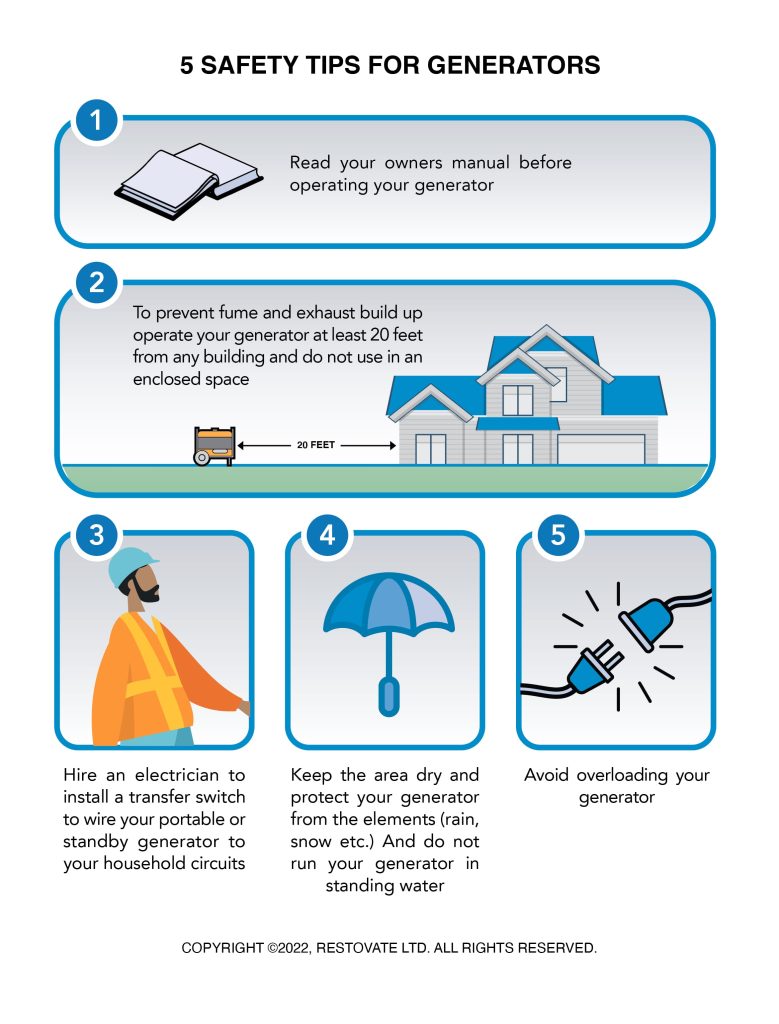
5 Safety Tips When Installing A Standby Generator
You can find more information on generator safety from the Electrical Safety Authority (ESA) at https://esasafe.com/safety/storm-safety/generator-safety/
Standby generators are your first line of defence for power outages in your home. They can protect your sump pump from stopping to work, your basement flooding, your pipes bursting in the winter, losing lots of money if food goes wrong, and more. In my opinion, it is the best way to protect one of the biggest investments that you will make.
RELATED
12 Steps After A Flood
How Much Should You Budget for Home Renovations?
Your Main Electrical Panel Explained









